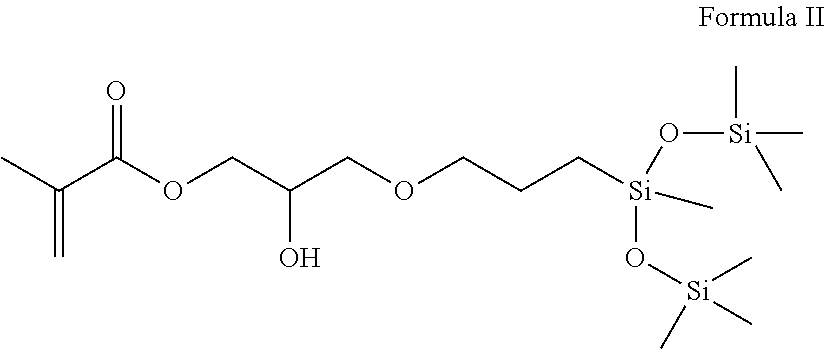Silicone polymers comprising sulfonic acid groups
a technology of sulfonic acid and polymer, which is applied in the field of silicone polymers/silicone hydrogels and ophthalmic devices, can solve the problems of displaying substantial amounts of lysozyme uptake, low oxygen permeability of hydrogel contact lenses, and generally low oxygen permeability
- Summary
- Abstract
- Description
- Claims
- Application Information
AI Technical Summary
Benefits of technology
Problems solved by technology
Method used
Image
Examples
example 1
Synthesis of Tripentylamine Salt of AMPS
[0111]To a stirred solution of 2.27 g of tripentylamine and 50 ml of ethyl acetate, 2.07 g of AMPS was added and allowed to continue to stir for 3 hrs. The ethyl acetate was removed on a rotary evaporator to yield a slight yellow liquid. This liquid was then washed with hexane in a separation funnel. The residual hexane was removed on a rotary evaporator yielding the tripentylammonium salt as a slight yellow ionic liquid (“AMPS Salt”).
[0112]The resulting ionic liquid appeared to remain stable for several days, but became visually more viscous after several weeks of storage at 5° C.
example 2
Manufacture of Silicone Hydrogel Formulations with AMPS Salt
[0113]The AMPS Salt prepared in Example 1 was used to prepare the formulation blends in Table 1. For each blend, all components were added and mixed on a jar roller until everything had dissolved. Both blends were clear.
[0114]
TABLE 1Blend FormulationsBlend 1Blend 2Componentwt %wt %OH-mPDMS26.0126.01mPDMS 100028.0128.01DMA21.0021.00PVP K-907.007.00HEMA6.506.50TEGDMA1.501.50AMPS SALT*7.507.50Norbloc2.002.00Irgacure 8190.480.48Decanoic acid (diluent)**9.200t-amyl alcohol (diluent)**13.800D30 (diluent)**023AMPS Concentration (mol / kg)***0.180.18*Note: The tripentylamine portion of the AMPS Salt was washed out of the polymer during hydration but is not calculated as part of the diluent in these blends.**Amounts of diluents are shown as weight percent of combination of all components. Amounts of other components are shown as weight percent of reactive components, excluding diluents.***AMPS concentration is reported as moles of AMP...
example 3
Manufacture of Silicone Hydrogel Formulations with AMPS without Non-Polymerizable Hydrophobic Amine
[0115]A blend was prepared as shown below in Table 2. The acid form of AMPS was first dissolved in the hydrophilic monomers (DMA, HEMA and TEGDMA) by mixing overnight on ajar roller. The rest of the components were then added and mixed on ajar roller. After 6 days of mixing on the jar roller, blend 3 remained hazy and contained lumps of phase separated material. These results demonstrate the need to use AMPS as a salt with a non-polymerizable hydrophobic amine when manufacturing a silicone polymer / hydrogel.
[0116]
TABLE 2Blend FormulationsBlend 3Componentwt %DMA23.75Blue HEMA0.00HEMA6.00TEGDMA1.50SiGMA27.86mPDMS 100030.81Norbloc2.00CGI 4030.24Irgacure 1840.24PVP K907.00AMPS0.60D30 (diluent)*23.00AMPS Concentration (mol / kg)0.03*Amounts of diluents are shown as weight percent of combination of all components. Amounts of other components are shown as weight percent of reactive components, e...
PUM
| Property | Measurement | Unit |
|---|---|---|
| average molecular weight | aaaaa | aaaaa |
| wt % | aaaaa | aaaaa |
| weight % | aaaaa | aaaaa |
Abstract
Description
Claims
Application Information
 Login to View More
Login to View More - R&D
- Intellectual Property
- Life Sciences
- Materials
- Tech Scout
- Unparalleled Data Quality
- Higher Quality Content
- 60% Fewer Hallucinations
Browse by: Latest US Patents, China's latest patents, Technical Efficacy Thesaurus, Application Domain, Technology Topic, Popular Technical Reports.
© 2025 PatSnap. All rights reserved.Legal|Privacy policy|Modern Slavery Act Transparency Statement|Sitemap|About US| Contact US: help@patsnap.com



